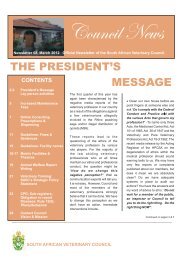Rabies Guide 2010.pdf - the South African Veterinary Council
Rabies Guide 2010.pdf - the South African Veterinary Council
Rabies Guide 2010.pdf - the South African Veterinary Council
You also want an ePaper? Increase the reach of your titles
YUMPU automatically turns print PDFs into web optimized ePapers that Google loves.
RABIES IN HUMANS<br />
32<br />
Epidemiology of human rabies<br />
<strong>Rabies</strong> is an ongoing scourge exacting an<br />
unnecessarily large toll on human life. The World<br />
Health Organization estimates about 55 000 human<br />
deaths in canine rabies endemic areas (31 000 in<br />
Asian countries and 24 000 in <strong>African</strong> countries)<br />
annually. 43, 44, 45, 159 <strong>Rabies</strong> virus is transmitted via <strong>the</strong><br />
saliva of infected animals and has <strong>the</strong> highest case<br />
fatality rate of any known human infection if <strong>the</strong><br />
disease has manifested. Once <strong>the</strong> virus has entered<br />
<strong>the</strong> central nervous system of <strong>the</strong> host, <strong>the</strong> resulting<br />
encephalomyelitis is fatal. Fortunately <strong>the</strong> availability<br />
of efficacious and safe vaccines and immunoglobulin<br />
has prevented many fatalities and almost 10 million<br />
people receive post-exposure prophylaxis annually<br />
after potential rabies exposure, mostly following dog<br />
bites.<br />
<strong>Rabies</strong> and <strong>the</strong> developing world<br />
<strong>Rabies</strong> remains endemic throughout <strong>the</strong> world except<br />
for certain Western European countries and a number<br />
of islands, but more than 99% of all human rabies<br />
deaths occur in <strong>the</strong> poorest developing countries. 45,46,47<br />
Recorded deaths in developing countries probably<br />
provide a gross underestimate of <strong>the</strong> true situation as<br />
<strong>the</strong>se areas generally have notoriously poor notification<br />
systems. Reasons underlying <strong>the</strong> preponderance of<br />
rabies cases in poor countries are complex but include<br />
opposing needs and limited resources for veterinary<br />
control, <strong>the</strong> prohibitive cost of post-exposure vaccine<br />
and immunoglobulin, poorly informed communities,<br />
inadequately trained health and veterinary staff, and<br />
inaccessibility of health-care facilities. 48,49,50<br />
Of considerable concern is <strong>the</strong> re-emerging status of<br />
rabies in Africa. 51,173 This trend has been attributed<br />
to rapid population growth with parallel dog<br />
population growth directed by security concerns,<br />
for example a growth of 4,7% in <strong>the</strong> dog population<br />
in Zimbabwe between 1954 to 1986, mobility of<br />
human populations, particularly political refugees,<br />
high rates of urbanisation and a disintegration<br />
of veterinary rabies control. 52,53,54 The latter is of<br />
particular importance as dog rabies vaccination is a<br />
more cost-effective measure for preventing human<br />
rabies than reliance on post-exposure prophylaxis for<br />
dog-bite victims. 55<br />
Distribution in <strong>South</strong> Africa<br />
During <strong>the</strong> first half of <strong>the</strong> 20th century most human<br />
rabies cases in <strong>South</strong> Africa resulted from herpestid,<br />
particularly yellow mongoose, bites in <strong>the</strong> central<br />
plateau areas. However, following <strong>the</strong> introduction of<br />
canid virus into Limpopo Province in <strong>the</strong> late 1940s,<br />
and later into KwaZulu-Natal in 1961, dogs became<br />
<strong>the</strong> most important source of human infection. In<br />
recent years (Table 9) <strong>the</strong> vast majority of <strong>South</strong><br />
<strong>African</strong> human rabies cases have followed bites from<br />
infected dogs in KwaZulu-Natal. 56,57 An outbreak of<br />
rabies in dogs coincided with a dramatic increase in<br />
<strong>the</strong> number of human cases in <strong>the</strong> Limpopo Province<br />
in 2006. 184<br />
Most victims have been children under <strong>the</strong> age of 10<br />
years. Children are particularly vulnerable because of<br />
<strong>the</strong>ir height, inquisitive nature, interest in animals<br />
and inability to protect <strong>the</strong>mselves. Surveillance of<br />
human rabies is poor in many parts of <strong>South</strong> Africa<br />
and it is likely that <strong>the</strong> situation may be worse than<br />
that reflected by official notifications. A careful<br />
history taken from a victim’s family has demonstrated<br />
a high sensitivity for diagnosing rabies in o<strong>the</strong>r<br />
<strong>African</strong> settings and may prove a useful approach in<br />
areas suspected of having rabies cases that have not<br />
been notified. 58<br />
Canine vaccine delivery targeted to highest risk<br />
populations and broad intersectoral collaboration are<br />
believed to have contributed to <strong>the</strong> marked reduction<br />
in human rabies in KwaZulu-Natal during <strong>the</strong> latter<br />
part of <strong>the</strong> 1990s. 59,60<br />
Transmission to humans<br />
Human rabies cases result from viral introduction<br />
through broken skin or mucosa through encounters<br />
with rabid animals, particularly bites but also scratches<br />
and nicks. Virus is usually present in <strong>the</strong> saliva of <strong>the</strong><br />
affected animal during clinical disease but secretion<br />
may be intermittent. Experimental demonstration of<br />
virus in salivary glands or saliva several days before
















